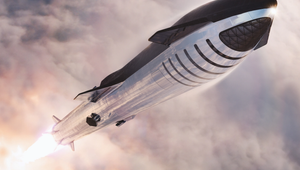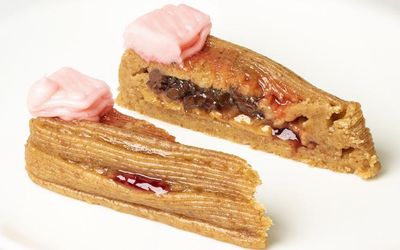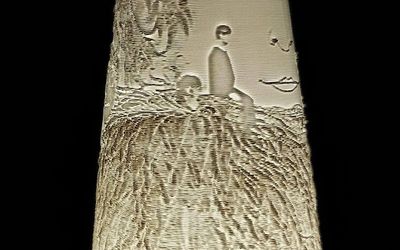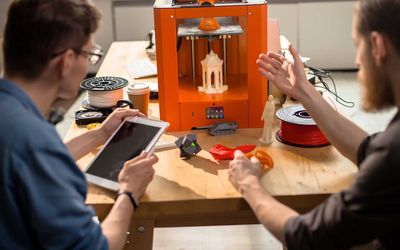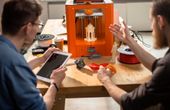Ultimaker S3
A dual extrusion 3D printer by Ultimaker uses fused filament fabrication for high-quality composite-ready medium-sized applications in a smaller footprint.
Technical Specifications
| Dimensions | |
| Build volume | 230 x 190 x 200 mm (9 x 7.4 x 7.9 inches) |
| Assembled Dimensions | 394 x 489 x 637 mm (15.5 x 19.3 x 25.1 inches) |
| Print Technology | Fused filament fabrication (FFF) |
| Compatible filament Diameter | 2.85 mm |
| Weight | 14.4 kg (31.7 lbs) |
| Power input | 100 - 240 VAC, 50 - 60 Hz |
| Maximum power output | 350 W |
| Printer Properties | |
| Layer resolution | 0.25 mm nozzle: 150 - 60 micron |
| 0.4 mm nozzle: 200 - 20 micron | |
| 0.6 mm nozzle: 400 - 20 micron | |
| 0.8 mm nozzle: 600 - 20 micron | |
| XYZ resolution | 6.9, 6.9, 2.5 micron |
| Feeder type | Dual-geared feeder, reinforced for composite materials |
| Display | 4.7-inch (11.9 cm) color touchscreen |
| Print Core replacement | Swappable print cores |
| Print head | Dual extrusion print head with an auto-nozzle lifting system and swappable print cores |
| Nozzle diameter | 0.25 mm, 0.4 mm, 0.6 mm, 0.8 mm |
| Operation Parameters | |
| Build speed | < 24 mm³/s |
| Nozzle temperature | 180 - 260 °C |
| Nozzle heat up time | < 2 minutes |
| Operating sound | < 50 dBA |
| Build plate leveling | Advanced active leveling |
| Build Plate | 20 - 140 °C heated glass build plate |
| Build plate heat-up time | < 4 minutes (from 20 to 60 °C) |
| Operating ambient temperature | 15 - 32 °C (59 - 90 °F) |
| Non-operating temperature | 0 - 32 °C (32 - 90 °F) |
| Ecosystem | |
| Supplied free software | Ultimaker Cura – print preparation software |
| Ultimaker Digital Factory – printer management software | |
| Software security | Data encryption in transit and at rest. Two-factor authentication |
| Supported OS | MacOS, Windows, and Linux |
| Plugin integration | SolidWorks, Siemens NX, Autodesk Inventor |
| Supported file types | Ultimaker Cura: STL, OBJ, X3D, 3MF, BMP, GIF, JPG, PNG |
| Printable formats: G, GCODE, GCODE.gz, UFP | |
| File Transfer | Wi-Fi, Ethernet, USB |
Overview
Problem / Solution
Quality manufacturing needs weeks to months of processes before achieving desired results. 3D printing saves this wasted time at a reduced cost by printing multiple parts without the need for tooling and extra technologies—which are expensive and time-consuming. It likewise reduces traditional manufacturing risks, which also require additional money and time. With 3D printing eliminating the need for molding and tooling, it nullifies potential missteps while allowing for more complex designs. It also projects resolving the long-time issue of sustainability in the manufacturing industry as it promotes reuse and recycling. As 3D printing promotes less wasteful processes at a relatively lower cost, the industry is bound to view 3D printing technology as a key to sustainability.
Ultimaker S3 is a dual extrusion 3D printer delivering quality performance for medium-sized projects at a smaller footprint. This easy-to-use device is powerful as it offers a cost-efficient way for in-house 3D printing. Its active bed leveling makes it more reliable as it ensures superb adhesion while constantly monitoring material flow during printing. The addition of Ultimaker Cura moves Ultimaker S3 to a very high standard when it comes to the reproduction of 3D models.
Design
Ultimaker S3 has a dimension of 394 x 489 x 637 mm (15.5 x 19.3 x 25.1 inches) and a mass of 14.4 kg (31.7 lbs). The XYZ resolution is at 6.9, 6.9, and 2.5 microns with a build volume of 230 x 190 x 200 mm (9 x 7.4 x 7.9 inches). The build speed is at < 24 mm3/s with an operating sound of < 50 dBA. The layer resolution per nozzle is as follows, 150-60 microns for the 0.25mm, 200-20 microns for the 0.4mm, 300-20 microns for the 0.6mm, and 600-20 microns for the 0.8mm. The compatible filament diameter measures 2.85mm.
Main Components
Moving in the X and Y direction, the dual extrusion print head releases filament from the nozzles with its auto-nozzle lifting system. Its two print cores are easily swappable. The heated build platform of the Ultimaker S3 is a glass build plate, which moves down per layer following the advanced active leveling. It has a 4.7-inch color touchscreen that efficiently displays menu options and information about the print.
Geared feeders deliver the material into the print head. This dual-geared feeder is reinforced with composite materials. Feeder 1 will guide material 1 to slot 1 of the print head and feeder 2 follows the same sequence. There is also a flow sensor that informs when the filament runs out, thus increasing print success.
Material Compatibility
The device is compatible with easy-to-print and visual quality using Ultimaker PLA and Ultimaker Tough PLA. Ultimaker ABS, PC, and CPE match well for materials requiring mechanical strength. For water resistance, Ultimaker Nylon, Ultimaker PP, and Igus Iglidur l180-PF offer the best results. For heat-resistant materials, use Ultimaker CPE+ or DSM Arnitel ID 2060 HT. Ultimaker CPE+ or DuPont™ Hytrel® 3D4100FL suits best for materials requiring flexibility. In reinforced composites, using Owens Corning XSTRAND™ GF30-PA6 or DSM Novamid® ID1030 CF10 stands out. For support materials, Ultimaker PVA and Ultimaker Breakaway can deliver target results.
Software
Ultimaker S3 supports Ultimaker Cura, a print preparation software, and Ultimaker Digital Factory, a management software. It provides security via data encryption and two-factor authentication features. It works in MacOS, Windows, and Linux software OS. The Ultimaker Cura supports the following file types: STL, OBJ, X3D, 3MF, BMP, GIF, JPG, PNG, and the printable formats include G, GCODE, GCODE.gz, and UFP. File transfer is available either via Wi-Fi, Ethernet, or USB.
Printing
Printing using the Ultimaker S3 can be done through the cloud, over a local network, or through USB. For cloud printing, an Ultimaker account must add the printer console to the Ultimaker Digital Factory. In printing over a local network, the Ultimaker Cura will send the print jobs to Ultimaker S3 that connects to the same network. Whereas saving the print file to a USB and plugging it into the Ultimaker S3 allows for offline printing.
Ultimaker S3 vs Ultimaker S5
Belonging to the same printer family, Ultimaker S3 and Ultimaker S5 share many key features and technologies but differ in certain aspects. While both open filament systems are compatible with the entire Ultimaker ecosystem, S3 has a smaller build volume of 230 x 192 x 200 mm compared to S5’s 330 x 240 x 330 mm. Ultimaker S5, unlike Ultimaker S3, benefits from peripherals like the Air Manager and Material Station. Although given Ultimaker S3’s smaller build plate, it consumes less power (350W max) when heated to the same temperature as the Ultimaker S5 (500W max).

